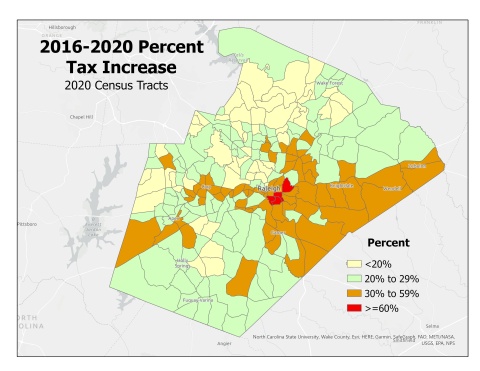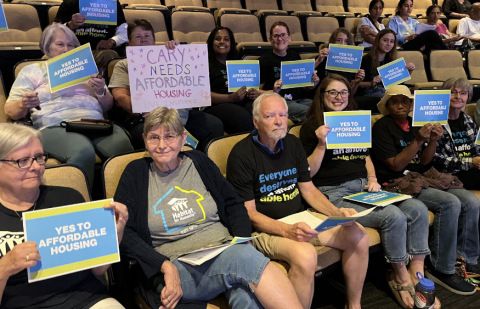What specific policies, practices, or initiatives will you implement to increase access to affordable housing across the county?
In addition to working with municipalities to enact forward-thinking planning and zoning ordinances as discussed above, Wake County should continue to put more affordable housing units in play each year, work to preserve naturally occurring affordable housing before it’s redeveloped and gone forever, better utilize land owned by the county and some of our partners, and assist cost-burdened homeowners who need help to stay in their homes.
In recent years, Wake County has made strides in expanding our affordable housing stock. Passed a few years ago, our landmark affordable housing plan has involved major changes in our housing apparatus: creating a stand-alone housing department, developing a proactive system to identify and preserve naturally occurring affordable housing, building record numbers of affordable housing units, expanding support services, creating rental and utility assistance programs, working with landlords on behalf of renters, etc. In 2021, we hit our five-year goal of creating 2,500 affordable housing units–and it was only year three.
In addition, I have been proud of the work that my Commission colleagues and I have done to build a surveillance program for identifying and tracking affordable housing so that we have early warning as to when each parcel is likely to come up for sale or is otherwise at risk of being redeveloped. We have also seeded a fund that is allowing us to partner with companies to raise millions of dollars to preserve this naturally occurring affordable housing. In the coming years, we must execute on these programs and spend the money wisely in furtherance of housing affordability.
Lastly, we should engage in programs that help not just renters but also property owners. See below.
What do you see as the biggest challenge facing affordable housing in Wake County?
While constructing more affordable housing units is critical, various experts who have examined Wake County’s housing dynamics tend to agree that government-supported housing alone will not allow us to “build our way out” of our affordable housing challenges. A systemic shortage of supply is perhaps the greatest influence on the structures that make housing less affordable, and people across the economic spectrum are negatively affected by it. Given that municipalities contain more than 80% of residents and an even greater percentage of current growth, my hope in the coming years is to serve as a conduit and convener among the county and its municipalities in order to develop collaborations concerning density, development, zoning, and other policy areas that affect housing dynamics. Thus, we must not only expand our efforts to create more affordable housing and to work vigilantly to preserve naturally occurring affordable housing, but we also need to work with our community partners to ensure that we make smart decisions about planning, permitting, zoning, transportation accessibility, and density, among other things.
Over 60 people move to Wake County every day. How do you plan to assist homeowners and prevent displacement due to rising housing costs such as property taxes?
We know that many people are forced from their homes by rising housing costs and other pressures. To address that challenge, we must redouble our housing affordability efforts, promote density, and make more development transit-accessible, and gather input from existing residents before making major planning decisions.
I have also been a leading advocate for measures that can help take pressure off of low-income families. While state law all but prohibits counties from adjusting property tax bills for those in acute need, we can implement programs that help low-income populations with other things that affect their cost of living, such as utility bills. As transportation is the second-largest cost for most families, providing additional public transit options will help as well. Lastly, we can better assist already-struggling families when they encounter one-time costs that might otherwise be crippling. One example is to create a no-interest loan fund that enables property owners to take care of needed home repairs so that they can maintain adequate shelter, heating, and other essentials.
These are just some of the measures I hope to pursue in the coming years. Tackling a complex problem such as this one will require a multi-pronged approach.
If (re)elected, how will you advance racial equity in housing?
First, we have to build equity practices into our organization and operations. We recently took a major step in the right direction when we hired our first DEI Director, a high-level position charged with analyzing, monitoring, and helping to craft not just Wake County’s internal practices, but also its external policies. Also, as chair of the Board of Commissioners in 2021, I was proud to partner with the Raleigh Chamber and many other organizations to create A Better Wake, which is a public-private partnership designed to “reimagine systems that create inequitable outcomes for Black and Brown residents.”
Because people of color are disproportionately low-income and disproportionately affected by housing affordability challenges, all of the affordable housing programs and policies I have discussed in response to other questions will work to help correct this inequity. In addition, the county has already put in place programs that target housing and upward mobility in neighborhoods that are populated disproportionately by Black and Brown families, and we should continue many of those site-based strategies.
Since owning a home is one of the most significant ways a family can build generational wealth, we should also develop a first-time home buyer assistance program that will help people who would otherwise be priced out of our hot housing market.
Lastly, we should not repeat the mistake of some other places in the country who concentrated new affordable housing solely in confined pockets. That might be convenient, but it risks concentrating poverty further and is often motivated by desires to keep poor people “out of sight.” Instead, while we have to be understanding of the complex dynamics of every region and neighborhood, a scattered-site policy is best.






